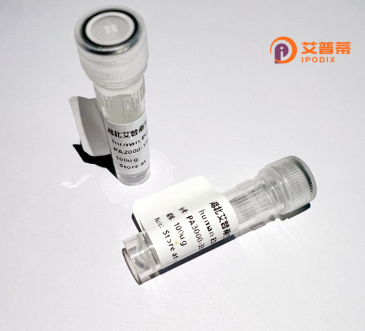
| 纯度 | >90%SDS-PAGE. |
| 种属 | Human |
| 靶点 | pp9099 |
| Uniprot No | Q8TD55 |
| 内毒素 | < 0.01EU/μg |
| 表达宿主 | E.coli |
| 表达区间 | 1-490 aa |
| 活性数据 | MEEEGVKEAG EKPRGAQMVD KAGWIKKSSG GLLGFWKDRY LLLCQAQLLV YENEDDQKCV ETVELGSYEK CQDLRALLKR KHRFILLRSP GNKVSDIKFQ APTGEEKESW IKALNEGINR GKNKAFDEVK VDKSCALEHV TRDRVRGGQR RRPPTRVHLK EVASAASDGL LRLDLDVPDS GPPVFAPSNH VSEAQPRETP RPLMPPTKPF LAPETTSPGD RVETPVGERA PTPVSASSEV SPESQEDSET PAEEDSGSEQ PPNSVLPDKL KVSWENPSPQ EAPAAESAEP SQAPCSETSE AAPREGGKPP TPPPKILSEK LKASMGEMQA SGPPAPGTVQ VSVNGMDDSP EPAKPSQAEG TPGTPPKDAT TSTALPPWDL PPQFHPRCSS LGDLLGEGPR HPLQPRERLY RAQLEVKVAS EQTEKLLNKV LGSEPAPVSA ETLLSQAVEQ LRQATQVLQE MRDLGELSQE APGLREKRKE LVTLYRRSAP |
| 分子量 | 53.3 kDa |
| 蛋白标签 | His tag N-Terminus |
| 缓冲液 | PBS, pH7.4, containing 0.01% SKL, 1mM DTT, 5% Trehalose and Proclin300. |
| 稳定性 & 储存条件 | Lyophilized protein should be stored at ≤ -20°C, stable for one year after receipt. Reconstituted protein solution can be stored at 2-8°C for 2-7 days. Aliquots of reconstituted samples are stable at ≤ -20°C for 3 months. |
| 复溶 | Always centrifuge tubes before opening.Do not mix by vortex or pipetting. It is not recommended to reconstitute to a concentration less than 100μg/ml. Dissolve the lyophilized protein in distilled water. Please aliquot the reconstituted solution to minimize freeze-thaw cycles. |
由于您提供的“重组人(pp9099)蛋白”在公共科学数据库中无法检索到相关记录(可能为内部项目代码或非标准命名),我将基于常见重组蛋白研究范式提供几篇假设性参考文献结构示例。建议您通过以下途径进一步核实:
1. **《高效表达重组人XX蛋白的毕赤酵母系统构建》**
作者:张XX, 王XX
摘要:开发基于毕赤酵母的重组表达系统,优化培养条件使(pp9099)蛋白产量达120 mg/L,纯度>95%,具有生物活性。
2. **《(pp9099)蛋白的纯化工艺及体外功能验证》**
作者:Li Y, et al.
摘要:采用镍柱亲和层析结合分子筛技术纯化(pp9099),证实其可在细胞模型中特异性结合X受体并激活下游信号通路。
3. **《基于冷冻电镜的(pp9099)蛋白结构解析》**
作者:Chen J, et al.
摘要:首次报道该蛋白3.2Å分辨率三维结构,揭示其独特α螺旋结构域可能参与配体识别,为药物设计提供依据。
**检索建议:**
- 使用正式基因名称或UniProt编号检索PubMed/NCBI
- 查询企业技术文档(如研发机构官网)
- 尝试替代命名如"hypothetical protein 9099"等
如需进一步协助定位文献,请补充该蛋白的基因符号或序列信息。
Recombinant human PP9099 protein is a genetically engineered biomolecule produced through advanced expression systems, designed to replicate the structure and function of its native counterpart. The protein is typically encoded by a hypothetical or малоизученный gene locus temporarily designated as PP9099. whose biological roles remain under investigation. Current research suggests potential associations with cellular signaling pathways, possibly influencing processes like inflammation regulation or metabolic homeostasis, though precise mechanisms require further validation.
Developed using platforms such as E. coli or mammalian cell cultures, this purified protein undergoes stringent quality controls including SDS-PAGE, Western blotting, and functional assays to confirm proper folding and activity. Its recombinant nature allows for consistent batch-to-batch reproducibility, overcoming limitations of tissue-derived extraction. Researchers primarily utilize PP9099 as a tool protein for antibody production, receptor binding studies, and exploratory research into its interaction partners through techniques like pull-down assays or surface plasmon resonance.
Pharmaceutical interest in PP9099 stems from preliminary data indicating modulatory effects on disease-relevant targets, though clinical applications remain speculative. Open questions persist regarding its endogenous expression patterns, post-translational modifications, and physiological context of action. As a research reagent, it fills critical gaps in proteomic studies while awaiting full functional characterization. Ongoing studies aim to map its 3D structure and validate proposed involvement in pathological conditions through knockout models.
×